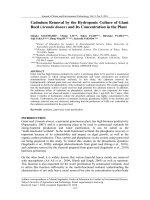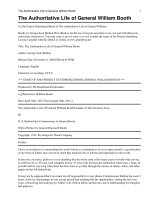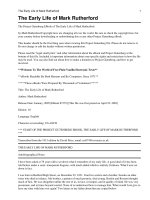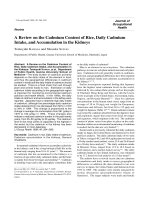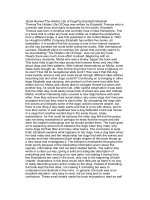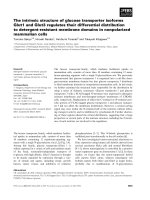STYLISTIC DEVICES DESCRIBING FAITH IN THE NOVEL ‘LIFE OF PI’ BY YANN MARTEL AND ITSVIETNAMESE EQUIVALENT TRANSLATED BY TRINH LU. MASTER THESIS IN SOCIAL SCIENCES ANDHUMANITIES
Bạn đang xem bản rút gọn của tài liệu. Xem và tải ngay bản đầy đủ của tài liệu tại đây (408.16 KB, 105 trang )
MINISTRY OF EDUCATION AND TRAINING
THE UNIVERSITY OF DANANG
HỒ THỊ THU TRANG
STYLISTIC DEVICES DESCRIBING FAITH IN
THE NOVEL ‘LIFE OF PI’ BY YANN MARTEL AND ITS
VIETNAMESE EQUIVALENT TRANSLATED BY TRINH LU
MASTER THESIS IN SOCIAL SCIENCES AND
HUMANITIES
Da Nang, 2015
2
MINISTRY OF EDUCATION AND TRAINING
THE UNIVERSITY OF DANANG
HỒ THỊ THU TRANG
STYLISTIC DEVICES DESCRIBING FAITH IN
THE NOVEL ‘LIFE OF PI’ BY YANN MARTEL AND ITS
VIETNAMESE VERSION TRANSLATED BY TRINH LU
Field study: THE ENGLISH LANGUAGE
Code: 60.22.02.01
MASTER THESIS IN SOCIAL SCIENCES AND
HUMANITIES
Supervisor: Hồ Vũ Khuê Ngọc, Ph.D.
Da Nang, 2015
i
STATEMENT OF AUTHORSHIP
Except where reference is made in the text of the thesis, this thesis
contains no material published elsewhere or extracted in whole or in part from
a thesis by which I have qualified for or been awarded another degree or
diploma.
No other person’s work has been used without due acknowledgements
in the thesis.
This thesis has not been submitted for the award of any degree or
diploma in any other tertiary institution.
Danang, 2015
Hồ Thị Thu Trang
ii
ABSTRACT
It goes without saying that stylistic devices are used as an important
means of literature to effectively capture readers’s attention. The proper use of
those devices enables the author to keep us interested while we are reading a
story. There are different kinds of stylistic devices and each kind of them
brings different effects to establish the mood and theme of the story. Hence,
this study attempts to investigate the stylistic devices describing faith in the
novel “Life of Pi” by Yann Martel and its Vietnamese version translated by
Trinh Lu. The data for analysis are 120 samples (60 in Vietnamese and 60 in
English) collected from the novel in two versions, English and Vietnamese.
The research is carried out based on the combination of a variety of methods,
namely qualitative, quantitative, descriptive and comparative. Data are
collected, described, analyzed and compared to find out the similarities and
differences of these features between the two languages.
Hopefully, the study could provide the readers a better insight into
stylistic devices describing faith in the novel “Life of Pi” and its Vietnamese
version, as well as help teachers, learners and translators of English
understand and use them more effectively.
iii
TABLE OF CONTENTS
STATEMENT OF AUTHORSHIP.................................................................i
ABSTRACT.....................................................................................................ii
TABLE OF CONTENTS...............................................................................iii
CHAPTER 1....................................................................................................1
INTRODUCTION...........................................................................................1
1.1. RATIONALE............................................................................................1
1.2. AIMS AND OBJECTIVES......................................................................4
1.2.1. Aims.......................................................................................................4
1.2.2. Objectives..............................................................................................4
1.3. RESEARCH QUESTIONS.....................................................................4
1.4. SCOPE OF THE STUDY........................................................................4
1.5. SIGNIFICANCE OF THE STUDY........................................................5
1.6. ORGANIZATION OF THE STUDY......................................................5
CHAPTER 2....................................................................................................6
LITERATURE REVIEW AND THEORETICAL BACKGROUND.........6
2.1. LITERATURE REVIEW........................................................................6
2.2. THEORETICAL BACKGROUND........................................................8
2.2.1. Stylistic Devices.....................................................................................8
2.2.2. Role of literary devices.......................................................................22
Literary devices are the heart and soul of every expression. These
devices breathe life in words which are common to all forms of a
language whether it is a narrative, story-writing, drama, journalistic
writing or poetry. Imagine a person's feelings, landscape, speech or views
on a subject, stated plainly without the aid of a literary device. It would
be a dull task. We all love to see our favorite characters delivering
wonderful dialogs with great passion and intensity, beautiful scenery well
iv
depicted, excellent speeches delivered or an opinion clearly reflected. All
these expressions are a manifestation of the beauty of words, which we
refer to as literary devices. The English language encompasses a host of
literary devices that make it so rich and expressive. They provide a broad
structure under which all the types of literature are classified, studied
and understood. The importance of literary devices therefore cannot be
underestimated..............................................................................................22
2.2.3. Translation..........................................................................................23
a. Definition of Translation..........................................................................23
Generally, translation is a process of rendering meaning, ideas, or
messages of a text from one language to other language. However, many
experts also gave different definitions of translation as follows:..............23
One of the most prominent one is stated by Newmark [1988] who defines
translation as “rendering the meaning of a text into another language in
the way that the author intended the text” [10, p.5]. This definition
stresses on rendering meaning of the source language text into the target
language text as what is intended by the author. Hatim and Munday
[2004] define translation as “the process of transferring a written text
from source language (SL) to target language (TL)” [9, p.6]. In this
definition they do not explicitly express that the object being transferred
is meaning or message. They emphasis on translation as a process. Nida
and Taber [1982], on the other hand, state that “translating consists in
reproducing in the receptor language the closest natural equivalent of the
source language message” [11, p.12]. This definition is more
comprehensive than the previous ones. Nida and Taber explicitly state
that translation is closely related to the problems of languages, meaning,
and equivalence.............................................................................................23
v
All in all, there are so many different definitions of translation but they
all share one thing in common. Translation is a process which is intended
to find meaning equivalence in the target text............................................24
b. Translation Methods................................................................................24
Newmark [1988] lists the following translation methods:........................24
Word-for-word translation: preservation of word order and as literal
translation as possible of individual words, including cultural words.....24
Literal translation: apart from as literal as possible translation of
individual words, grammatical structures are converted into the nearest
target language equivalents..........................................................................24
Faithful translation: stays, if possible, within the constraints of the
grammatical structures of the target text, but draws on certain
contextual factors..........................................................................................24
Semantic translation: more emphasis on naturalness than in faithful
translation, and translation of certain cultural words into neutral
equivalents in the TL.....................................................................................24
Communicative translation: aims at reproducing the exact message of the
source text content-wise and context-wise but with emphasis on
naturalness and acceptability/comprehensiveness to the target text
readership.......................................................................................................24
Idiomatic translation: makes use of idioms and colloquialisms that are
not present in the source text........................................................................24
Free translation: focuses on the content of the target text rather than the
form, which means that the same content is expressed in the target text
but with very different grammatical structures.........................................24
vi
Adaptation: the freest form of translation and more of a target
language/culture based on the interpretation of the source text than a
translation......................................................................................................25
c. Translation Procedures.............................................................................25
2.2.4. The Author Yann Martel.....................................................................26
2.2.5. The Novel “Life of Pi”........................................................................27
2.2.6. Translator Trinh Lu...........................................................................29
2.2.7. Literary values of the novel “Life of Pi”..........................................30
CHAPTER 3..................................................................................................32
RESEARCH DESIGN AND METHODOLOGY.......................................32
3.1. RESEACH DESIGN..............................................................................32
3.2. RESEARCH METHODS......................................................................33
3.3. DATA COLLECTION...........................................................................34
3.4. DATA ANALYSIS...................................................................................34
3.5. RESEARCH PROCEDURES...............................................................35
CHAPTER 4..................................................................................................36
FINDINGS AND DISCUSSION..................................................................36
4.1. LEXICAL STYLISTIC DEVICES.......................................................36
4.1.1. Metaphor.............................................................................................36
4.1.2. Hyperbole............................................................................................46
4.2. SYNTACTICAL STYLISTIC DEVICES............................................49
4.2.1. Rhetorical Question............................................................................49
4.2.2. Repetition............................................................................................53
4.3. LEXICO-SYNTACTICAL STYLISTIC DEVICES...........................59
4.3.1. Climax.................................................................................................59
4.3.2. Paradox...............................................................................................69
4.3.3. Simile...................................................................................................72
vii
4.5. REMARKS OF STYLISTIC DEVICES DESCRIBING FAITH IN
“LIFE OF PI” IN ENGLISH AND ITS VIETNAMESE EQUIVALENT
.........................................................................................................................83
CHAPTER 5..................................................................................................84
CONCLUSION - IMPLICATIONS............................................................84
LIMITATIONS - RECOMMENDATIONS................................................84
5.1. CONCLUSION.......................................................................................85
5.2. IMPLICATIONS OF THE STUDY......................................................86
5.2.1. Implications for students...................................................................86
5.2.2. Implications for teachers...................................................................87
5.2.3. Implications for translators...............................................................89
5.3. LIMITATIONS OF THE STUDY.........................................................90
5.4. SUGGESTIONS FOR FURTHER STUDIES.....................................91
REFERENCES................................................................................................1
viii
LIST OF ABBREVIATIONS
SD
Stylistic device
SDs
Stylistic devices
ST
Source text
SL
Source language
TT
Target text
TL
Target language
ix
LIST OF TABLES
Number
Name of tables
4.1
Frequency of Occurrence of Stylistic Devices used in
Page
83
describing faith in the novel “Life of Pi” and its
4.2
Vietnamese equivalent
Translation Procedures of Stylistic Devices used in
describing faith in the novel “Life of Pi”
84
1
CHAPTER 1
INTRODUCTION
1.1. RATIONALE
Faith is the very sum and substance of life. Without faith, human beings
cannot achieve anything. If we observe all the greatest Endeavour’s carried
out in this world, we will find that behind them faith was the sole-driving
force. A person can set a goal for himself, only if he has faith that ultimately
he will achieve the goal. Thus, faith forms the foundation of every new
achievement, every new invention, every new discovery and every new
victory.
Yann Martel’s “Life of Pi” is the novel that has won The Man Booker
Prize awarded for the best original full-length novel, and written in English
language. Since it first published in 2002, “Life of Pi” becomes one of the
particular novels that made that year. It inspires people with motivation,
strength and strong will to overcome enormous obstacles and brings life with
full of colors and atmosphere. Yann Martel made the impossible possible with
faith - the very beautiful thing in this world. Throughout the story, a human
being named Piscine Molitor Patel spent 227 days on a lifeboat in the middle
of the Pacific Ocean with a Bengal Tiger. To live over this despaired situation,
he must have had an amount of persistence, hope, and faith more vast than the
Pacific Ocean itself. Particularly, faith is the number one source of survival
and happiness during the tragedy.
“Life of Pi” is a story within a story within a story. The significant way
of storytelling and the natural depiction of belief has contributed to the high
success of the novel. Thanks to the stylistic devices (SDs) describing faith in
the novel, the author can draw vivid pictures with good art without describing
2
what exactly happen. Martel actually displays the clever voice and
tremendous storytelling skills of an emerging master in using them to activate
and fire imagination in readers, with an assurance that “I have a story that will
make you believe in God”. The way SDs used throughout the story not only
helps to develop the level of faith – from God to ourselves – but also is a
marvelous feat of imagination and inquiry. They truly have a great power of
expressive meaning in the novel. Furthermore, the remarks of SDs used in
describing faith in the novel and its Vietnamese translational equivalent are
what made me deeply curious and excited. Taking the below paragraph as an
example.
“I am a Hindu because of sculptured cones of red kumkum powder
and baskets of yellow turmeric nuggets, because of garlands of flowers and
pieces of broken coconut, because of the clanging of bells to announce one’s
arrival to God, because of the whine of the reedy nadaswaram and the beating
of drums, because of the patter of bare feet against stone floors down darn
corridors pierced by shafts of sunlight, because of fragrance of incense,
because of flames of arati lamps circling in the darkness, because of bhajans
being sweetly sung, because of elephants standing around to bless, because
of colourful murals telling colourful stories, because of foreheads carrying,
variously signified, the same word – faith.” [1, p.59-60]
“Tôi là một tín đồ Hindu bởi những thỏi nhang hình cơn nặn bằng bột
kum kum màu đỏ và những giỏ trầm vàng, bởi những vòng hoa kết và những
mẫu cùi dừa, bởi tiếng chuông ngân dài dọn bước chân người đến với
Thượng đế, bởi những âm thanh khắc khoải của cây sáo sậy nadaswaram và
tiếng trống đổ dồn, bởi tiếng chân trần bước trên sàn đá những hành lang tối
có những tia sáng mặt trời xuyên nghiêng huyền ảo, bởi hương thơm của
nhang, bởi lưỡi lửa của các cây đèn arati chập chờn trong bóng tối, bởi những
3
khúc ca bhajan cất lên ngọt ngào làm vậy, bởi bầy voi đứng chầu quanh đền
đợi bởi bầy voi đứng chầu quanh đền đợi ban phước lành, bởi những bức
tranh tường kể bao câu chuyện lung linh, bởi những vầng trán mang trên
chúng những ký hiệu khác nhau của chỉ một từ - niềm tin.” [2, p.85]
Yann is describing how the familiarity of what Pi has grown up with as
“religion” is comforting to him and how it became the spark within him that
lit the fire of his love for God by using SDs like Metaphor and Polysyndeton.
He uses Polysyndeton “because of” in writing as thinking that there are
various simple and familiar things around us representing for God. God is like
a father creating the beauty of life, and loving life is just like loving God.
Besides, Yann also uses metaphor “colourful murals telling colourful stories”
to imply that murals themselves cannot tell stories like human beings,
however, through murals-wall paintings we can understand or imagine what
happened or even what will happen in our daily life. In fact, Trinh Lu tries to
maintain the meaning and linguistic style of Martel in the text except putting
one more Metaphor in describing how the bell resound like a person to
announce the appearance of God.
All in all, faith is a very large and interesting topic to discuss,
especially with the very unique linguistic style of Yann Martel using SDs in
the novel, because it can reveal the true intention why the main character
chooses faith rather than anything for life. Hence, this is the reason for me to
do this study which is intended to investigate and compare the features of
some “Stylistic Devices Describing Faith in the Novel “Life of Pi” by
Yann Martel and its Vietnamese Equivalent Translated by Trinh Lu”. In
addition, this study might help us deal with this part of English language more
carefully to contribute a small part to learning and teaching literature,
translation as well as writing.
4
1.2. AIMS AND OBJECTIVES
1.2.1. Aims
This paper is designed to study different SDs describing faith in the
novel “Life of Pi” by Yann Martel and its Vietnamese equivalent translated by
Trinh Lu. The comparison of SDs in the two languages put forward some
suggestions for useful applications on the teaching, learning and translation of
English, on the understanding and using SDs in describing faith in particular
and in writing in general.
1.2.2. Objectives
The study is intended to:
- Identify and analyze SDs describing faith in the English novel “Life
of Pi” and its Vietnamese translational equivalent.
- Highlight the remarks of SDs used in the novel and its translational
equivalent.
- Suggest some implications of using SDs on teaching, learning and
translation of literature as well as writing texts related to faith.
1.3. RESEARCH QUESTIONS
In order to achieve the aims and objectives of the study, the researcher
must answer the following questions:
1. What SDs are used to describe faith in the novel “Life of Pi” by Yann
Martel?
2. How are these SDs translated into Vietnamese?
3. What are the implications of the findings for understanding and using
SDs to describe faith in translation as well as writing?
1.4. SCOPE OF THE STUDY
In this thesis, I focus on examining the SDs describing faith in the
novel “Life of Pi” by Yann Martel and its Vietnamese translational equivalent,
5
including analyzing lexical SDs, syntactical SDs and lexico-syntactical SDs.
From the comparison of SDs used in the novel and its equivalent, I present
some pragmatic features of using SDs in describing faith - one of the major
factors that earn the novel’s popularity and recognition.
1.5. SIGNIFICANCE OF THE STUDY
The study has values in both theoretical and practical aspects.
Theoretically, the study helps to have good insight into the SDs describing
faith and find out the remarks of SDs in the English novel “Life of Pi” by
Yann Martel and its Vietnamese equivalent translated by Trinh Lu. Practically,
it helps to find out the effectiveness of those linguistic features when applying
to the act of describing faith in translation and writing.
1.6. ORGANIZATION OF THE STUDY
The study consists of five chapters as follows:
Chapter 1, Introduction
Chapter 2, Literature Review and Theoretical Background
Chapter 3, Research Design and Methodology
Chapter 4, Findings and Discussions
Chapter 5, Conclusion – Implications – Limitation - Recommendation
6
CHAPTER 2
LITERATURE REVIEW AND THEORETICAL
BACKGROUND
2.1. LITERATURE REVIEW
So far, many famous linguists and grammarians in the world such as
Galperin [1977], Bazerman [1988], Bradford & Richard [1997], Kramsch
[2003], Verdonk [2003], Simpson [2004] have shown their particular interest
in the topic of SDs and investigated different aspects of them to find out their
theoretical and practical significance. For instance, in Galperin’s famous book
named “Stylistics”, he wrote: “Stylistics is a domain where meaning assumes
paramount importance. This is so because the term ‘meaning’ is applied not
only to words, word - combination, sentences but also to the manner of
expression into which the writer is cast”. He also described “the word is, of all
language units, the most sensitive to change, its meaning gradually develops
and as a result of this development, new meanings appear alongside the
primary one” and of course “when a word begins to manifest an interplay
between the primary and one of the derivative meanings we are again
confronted with a stylistic device.” [3, p.148].
In Vietnamese, the topic of SDs is also a matter of concern to several
linguists such as Đinh Trọng Lạc & Nguyễn Thái Hòa [1995], [1993]; Hữu
Đạt [2001], Lê Lưu Oanh & Phạm Đăng Dư [2008]. In their books, the
authors have provided clear definitions, functions of SD in Vietnamese and
their own viewpoint on stylistic devices.
Furthermore, SDs are also taught and researched in university
departments of language, literature and linguistics the world over. For
instance, there are some international research articles such as Abioye [2009]
7
examined style and the concept of the Rhetorical Question as well as
identified typology of it (about 8 different types) in newspapers and other
forms of discourse. This idea is to highlight reasons why teachers and writers
should spice up and embellish the variety of styles available for use. Huang
[2011] reports a study applying stylistics in the analysis and assessment of
literary translation, with specific reference to translations between English
and Chinese. It focuses on how to maintain the original style in the translation
- in terms of techniques or linguistic features in the literary texts and their
correspondent functions - and on how to assess the style of the individual
translation and translator. Dubovičienė & Skorupa [2014] described the use
and purpose of linguistic devices in print advertising. In Vietnam, SDs are
chosen to be analyzed in many graduation papers of master class such as Phan
Thị Uyên Uyên [2006] highlighted the differences and similarities of using
SDs in advertising language in English and Vietnamese newspaper; Hoàng
Kim Anh [2008] worked out the similarities and differencies of SDs in
English and Vietnamese proverbs; Lê Thị Lai [2011] found out some SDs
commonly used to describe natural scenery in English and Vietnamese literary
works and Đỗ Thị Qúy [2014] investigated into the use of SDs which are
translated from the novel “Số Đỏ” by Nguyễn Trọng Phụng. All of them gave
us a general knowledge of this topic and marked the importance of
researching rhetorical devices.
Likewise, there are also a lot of comments and feedbacks on Yann
Martel and his literary work “Life of Pi” like Krist, Gary [2002]: “Life of Pi is
a multileveled exploration of the beautiful mysteries that light up our lives
and have no rhyme nor reason of their own. Yet without them, we would be
nothing more than wonder-deprived creatures.” [34] As stated by Frederic &
Brussat [2014] that “These are small nits, though. Reading Life of Pi, you find
8
yourself at the mercy of a great storyteller. Yann Martel will dazzle you with
his prose and his mastery of arcane facts, and challenges you to believe his
story. You will be left with a better understanding of animals, including man,
and much to ponder and question. Life of Pi is a delicious treat to savor.” [35]
However, there has not been any research on language used to describle Faith
up to now. Therefore, I would like to have an investigation into a very
meaningful aspect of the novel - Faith and the extraordinary writing style of
Yann Martel in using SDs to send the message of faith effectively to the
readers.
Thanks to these selection and supplementary ideas of all the works
mentioned above, this study is carried out and expected that the findings will
provide a better insight to SDs describing faith in the novel “Life of Pi” by
Yann Martel and its Vietnamese equivalent translated by Trinh Lu.
2.2. THEORETICAL BACKGROUND
2.2.1. Stylistic Devices
a. Definition of Stylistic Devices
SDs (also called rhetorical devices or figures of speech) are considered
as distinctive linguistic expressions which make writings more effective,
persuasive and successful for various purposes. Galperin [1977] defined SD
that “It is a conscious and intentional intensification of some typical structural
and/or semantic property of a language unit (neutral or expressive) prompted
to a generalized status and thus becoming a generative model.” “It deals with
the result of the act of communication. It means that Rhetorical takes into
consideration the output of the act of communication.” It follows then that “A
stylistic device is an abstract pattern, a mould into which any content can be
poured. As is known, the typical is not only that which is in frequent use, but
that also which reveals the essence of a phenomenon with the greatest and
9
most evident force.” [3, p.12] In addition, in the book “Giáo trình lý luận văn
học” [2007] Lê Lưu Oanh and Phạm Đăng Dư said “Using SDs in literary text
means using words to build or create an artist image, to express viewpoints of
life. If we can use different lines and colours in painting; different tunes,
rhythm, timbres, sounds, melodies in music; certainly we can also use
peculiar techniques in literature”. [25, p.56]
Interestingly, there are so many linguists and researchers who
discovered the mystery, the beauty and the force of the rhetorical devices in
their own way. These theories are great and useful sources for readers to
understand clearly, deeply and sufficiently the topic.
b. Functions of Stylistic Devices
According to Bazerman [1988]: “The basic function of rhetoric is the
used of words by human agents to form attitudes or to include actions in other
human agents” and “It is rooted in the essential function of language itself, a
function which is wholly realistic and continually born anew.” [4, p.34]
Hence, SDs are used in writing to make it more effective and persuasive by
emphasizing an attitude or opinion, arousing readers’ interest, making remark
vivid and unforgettable, making a train of thought more obvious to the
audience, creating vivid mental images, entertaining readers as well as
criticizing.
c. Classification of Stylistic Devices
According to principles of their formation, SDs are grouped into lexical,
syntactical, lexico-syntactical and phonetical types.
- Lexical Stylistic Devices
Lexical SDs are further classified according to the nature of lexical
meanings participating in their formation.
10
SDs based on the Interaction between the Logical and Nominal
Meanings of a word.
Antonomasia is employed when the proper name of a person, who is
famous for some reasons, is put for a person having the same feature. For
example: Her husband is an Othello. Besides, it is used as a common noun
instead of the proper name.
There must have fixed logical associations
between the name itself and the qualities of its bearer which may occur only
as a result of long and frequent usage. The main function of this type of
antonomasia is to characterize the person simultaneously with naming him
such as Lady Teasle; Miss Sharp; Mr. Credulous.
SDs based on the Interaction between Two Logical Meanings of a
word.
Metaphor compares two different things in a figurative sense. Unlike
in a simile (A is like B), like and as is not used in metaphor (A is B). It is a
relation between the dictionary and contextual logical meanings based on the
similarity of certain properties or features of the two corresponding concepts.
Đinh Trọng Lạc [2003] said “Metaphor is the substitution of name or the
transference of attribute of this thing to another, based on their association
with mutual characteristics.” [24, p.57]
For example:
- All the world is a stage, and all the men and women merely players.
(Shakespear)
- Truths are first clouds, then rain, then harvest and food. (Beecher)
Personification is a kind of metaphor in which animals, plants,
inanimate objects or abstract ideas are represented as if they were human
beings and possessed human qualities. It is considered one of outstanding
rhetorical devices in the field of stylistics. As Abrams mentioned in the book
“A Glossary of Literary Terms”: “in personification, either an inanimate
11
object or an abstract concept is spoken of as though it were endowed with life
of with human attributes or feelings.” [5, p 134]
For example:
- Justice is blind.
- Necessity is the mother of invention.
Metonymy reflects the actually existing relations between two objects
and is thus based on their contiguity. According to Galperin [1977],
“Metonymy is based on different types of relation between the dictionary and
contextual meanings, a relation based not on affinity, but on some kind of
association connecting the two concepts which these meanings represent.” [3,
p.140] Metonymy is expressed by nouns or substantivized numerals.
For example:
- She was a pale and fresh eighteen. (Metonymy A pale and fresh
eighteen is in place of the girl who is eighteen years old is pale and fresh.)
- He could feel the steel going right through him. (Metonymy Steel is
used to replace for dagger or knife.)
Irony is the clash of two diametrically opposite meanings within the
same context, which is sustained in oral speech by intonation. Irony can be
realized also through the medium of the situation, which, in written speech,
may extend as far as a paragraph, chapter or even the whole book. Bitter,
socially or politically aimed irony is referred to as sarcasm.
For example:
- Teacher said: “You are absolutely the best class I’ve ever had.”
(Actual meaning: the worst class)
- “Go ask his name: if he be married
My grave is like to be my wedding bed.”
12
Juliet commands her nurse to find out who Romeo was and says if he
were married, then her wedding bed would be her grave. It is a verbal irony
because the audience knows that she is going to die on her wedding bed.
SDs based on the Interaction between the Logical and Emotive
Meanings of a word.
Hyperbole is a deliberate overstatement or exaggeration of some
quantity, quality, size, etc. According to Galperin, “Hyperbole can be defined
as a deliberate overstatement or exaggeration of a feature essential to the
object or phenomenon.” [3, p.176] Its purpose is to emphasize something or
to produce a humorous effect. It, however, does not aim at giving wrong
information or telling a lie. It does not make us believe in what is described
but helps us understand clearly about it.
For example:
- “I love Ophelia: forty thousand brothers could not, with all their
quantity of love make up my sum.” (Shakespeare, 1603)
- I am so hungry I could eat a horse.
Oxymoron is a combination of two words (mostly an adjective and a
noun or an adverb and an adjective) whereby the meanings of the two clash,
being opposite in sense. [3, p.158]
For example:
-“Ralph, if you're gonna be a phony, you might as well be a real
phony.” (Richard Yates, 2002)
- Please, I didn't kill anyone. I'm an extreme pacifist.
(Andrew J. West and Emily Deschanel, 2009)
It is clear that the noun phrases in the examples above contain two
different contradictory meanings: “real-phony”, “extreme-pacifist”.
SDs based on the Interaction between the Free and Phraseological
Meanings of a word.
13
The main stylistic function of the indicated SD is to create humorous
effect. Proceeding from the quality of the context and the structure of the SD
we shall differentiate:
Zeugma is a strong and effective device to maintain the purity of the
primary meaning when two meanings clash. It is defined as the use of a word
in the same grammatical but different semantic relation to two adjacent words
in the context, the semantic relation on the one hand literary, and on the other
hand transferred. [3, 145] In other words, the context allows to realize two
meanings of the same polysemantic word without the repetition of the word
itself.
For example:
- “And May’s mother always stood on her gentility, and Dot’s mother
never stood on anything but her active little feet.” (Dickens)
In the sentence, the word “stood” is used twice. The structural variant
of zeugma makes the reader realize that the two meanings of the word “stand”
are simultaneously expressed, one literal and other transferred.
Pun is an idea or expression which has two meanings implied at the
same time. Quite often, it is used to pass a witty remark or bring about a
sarcastic effect.
For instance:
- Is life worth living?
It depends on the liver.
In this riddle, liver can refer to someone who lives or a large organ in
the body that cleans the blood and produces bile.
- Syntactical Stylistic Devices
Syntactical SDs deal with the syntactical arrangement of the utterance
which creates the emphasis of the latter irrespective of the lexical meanings of
the employed units. It should be observed here that oral speech is normally
more emphatic than the written type of speech. Depending upon the part of the
14
syntactical structure that is endowed with contextual meaning to create the
emphasis of the whole structure we differentiate the following syntactical SDs:
Inversion aims at attaching logical stress or additional emotional
coloring to the surface meaning of the utterance. Therefore a specific
intonation pattern is the inevitable satellite of inversion. Inversion as a
stylistic device is always sense - motivated. It is most frequently met in both
English prose and English poetry. It can highlight description, change writing
style and avoid monotonous repetition in using language. Inversion must be
regarded as an expressive means of language having typical structural models.
Take into consideration these examples following:
- “Once upon a midnight dreary…” (E. A. Poe, 1845)
- “A good generous prayer it was” (Mark Twain, 1876)
- “Down dropped the breeze…” (Coleridge, 1798)
Rhetorical question, according to Abram [1957], is a sentence in the
grammatical form of a question which is not asked in order to request
information or to invite a reply, but to achieve an expressive force different
from, and usually more effective than, a direct assertion. In everyday
discourse, for example, if we utter the rhetorical question “Isn’t it a shame?”
it functions as a forceful alternative to the assertion “It’s a shame.” The figure
is often used in persuasive discourse. [5, p.76] So the rhetorical questions may
be defined as utterances in the form of questions which pronoun judgments
and also expresses various kinds if modal shapes of meaning as doubt,
challenge, scorn, etc.
- Don’t we all love peace and hate war?
- Shouldn’t we try to be friendlier towards each other?
Ellipsis: The part of a sentence or an event that is left out by
